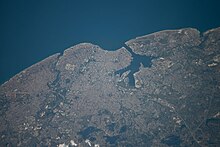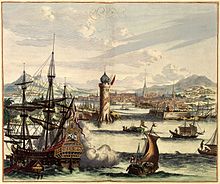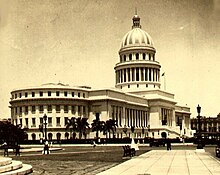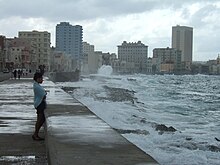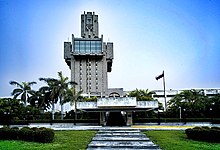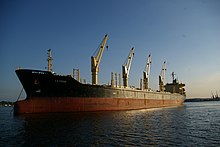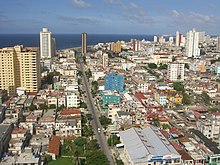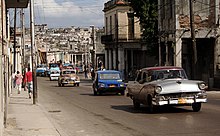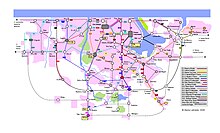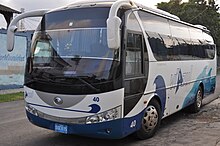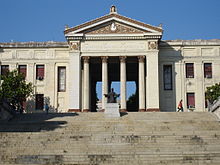Havana
| La Habana | |
|---|---|
|
Coordinates: 23 ° 7 ′ N , 82 ° 23 ′ W
La Habana on the map of Cuba
|
|
| Basic data | |
| Country | Cuba |
| province | La Habana |
| City foundation | November 16, 1519 |
| Residents | 2,121,871 (2014) |
| City insignia | |
| Detailed data | |
| surface | 728.26 km² |
| Population density | 2892.0 inhabitants / km 2 |
| height | 59 m |
| City structure | 15 districts |
| Waters | Florida Street , Río Almendares |
| Post Code | 10200, 10900, 10100 |
| prefix | (+53) 7 |
| Time zone | UTC -5 |
| City Presidency | Reinaldo García Zapata ( PCC ) |
| City patron | San Cristobal |
| Swell: | |
| Havana skyline. View from the lighthouse ( El Morro ) | |
| View of the Capitol in Havana | |
Havana ( Spanish La Habana ), full name Villa de San Cristóbal de la Habana , is the capital of the Republic of Cuba and at the same time an independent province . With around 2.10 million inhabitants and an area of 728.26 km², it is the second largest metropolis in the Caribbean after Santo Domingo . The city borders in the north on the Atlantic Ocean or the Strait of Florida and extends south and west of the Bay of Havana (" Bahía de La Habana "). The river Almendares crosses the city from south to north and finally flows west of the bay into the Florida Strait. The bay to the east of the center is home to the city's three major ports: Marimelena, Guanabacoa and Atarés.
Havana was founded by the Spanish in 1519 due to its strategic location . The city served as a fulcrum from which the Spanish conquered the Caribbean-Central American region as far as North America. Philip II of Spain granted Havana city charter in 1592, but Havana had been the capital of Cuba since 1552. The sinking of the USS Maine in Havana Harbor in 1898 immediately sparked the Spanish-American War .
The city is the political center of the country and the seat of government, numerous ministries and companies as well as over 90 embassies. Marta Hernández Romero ( PCC ) has been the mayor of Havana since 2011 . The city is also a tourist center of Cuba, in 2010 1.17 million tourists visited the city, 46% of all visitors to the country. The old town, La Habana Vieja , has been a UNESCO World Heritage Site since 1982 .
Surname
The town of La Villa de San Cristobal de La Habana was on 16 November 1519 at the behest of the Spanish king and Holy Roman Emperor Charles V established. The name is made up of the name of the city's patron, San Cristóbal , and the name under which the settlement was previously known: Habana . The inhabitants of Havana are called Habaneros .
There are various hypotheses about the origin of the name Habana . The most common of them says that the name can be traced back to a local Taíno chief named Habaguanex, who controlled the areas of the first settlement on the south coast of today's Mayabeque province .
geography
location
Havana is located on the northwest coast of Cuba, south of the Florida Keys , where the Gulf of Mexico meets the Caribbean. The city extends mainly south and west of the bay, which divides the city into its three main ports: Marimelena, Guanabacoa, and Atarés. The Almendares River flows through the city from the south and flows into the Florida Strait a few kilometers west of the bay.
The city is situated on low hills that rise slightly above the strait. One of the highest points is a 60-meter-high limestone hill that extends from the east of the city to the colonial fortresses of La Cabaña and El Morro . There is also a slight elevation in the western part of the city in the area of the University of Havana . Outside the urban area, Havana is bordered by higher hills to the west and east.
City structure
Havana is an independent Cuban province. Havana can be roughly divided into the inner-city districts of Old Havana ( Habana Vieja ), Centro Habana and Vedado as well as the suburbs. Havana's old town is a UNESCO World Heritage Site and there are also many tourist attractions such as Plaza Vieja or the Malecón promenade .
In the newer district of Vedado, which is located in the north-west of the city, numerous nightlife facilities and shopping opportunities were created, especially in the 20th century , which today compete with those in the old town.
The city is divided into 15 districts ( Municipios ), which in turn are subdivided into 105 districts ( Consejos populares ):
- Playa : Santa Fe, Siboney, Cubanacán, Ampliación Almendares, Miramar , Sierra, Ceiba, Buena Vista.
- Plaza de la Revolución : El Carmelo, Vedado-Malecón, Rampa, Príncipe, Plaza, Nuevo Vedado-Puentes Grandes, Colón-Nuevo Vedado, Vedado .
- Centro Habana : Cayo Hueso, Pueblo Nuevo, Los Sitios, Dragones, Colón.
- La Habana Vieja : Prado, Catedral, Plaza Vieja , Belén, San Isidro, Jesús Maria, Tallapiedra.
- Regla : Guaicanimar, Loma Modelo, Casablanca .
- La Habana del Este : Camilo Cienfuegos, Cojimar , Guiteras, Alturas de Alamar , Alamar -Este, Guanabo , Campo Florido, Alamar-Playa.
- Guanabacoa : Mañana-Habana Nueva, Villa I, Villa II, Chivas-Roble, Debeche-Nalon, Hata-Naranjo, Peñalver-Bacuranao, Minas-Barreras.
- San Miguel del Padrón : Rocafort, Luyanó Moderno, Diezmero , San Francisco de Paula, Dolores-Veracruz, Jacomino.
- Diez de Octubre : Luyanó, Jesús del Monte, Lawton, Vista Alegre, Acosta, Sevillano, La Víbora , Santos Suárez, Tamarindo.
- Cerro : Latinoamericano, Pilar-Atares, Cerro, Las Cañas, El Canal, Palatino, Armada.
- Marianao : CAI-Los Ángeles, Pocito-Palmas, Zamora-Cocosolo, Libertad, Pogoloti-Belén-Finlay, Santa Felicia.
- La Lisa : Alturas de La Lisa, Balcón Arimao, Cano-Bello26-Valle Grande, Punta Brava , Arroyo Arenas, San Agustín, Versalles Coronela.
- Boyeros : Santiago de Las Vegas , Nuevo Santiago, Boyeros, Wajay, Calabazar, Altahabana-Capdevila, Armada-Aldabo.
- Arroyo Naranjo : Los Pinos, Poey, Víbora Park, Mantilla, Párraga, Calvario-Fraternidad, Guinera, Eléctrico, Managua, Callejas.
- Cotorro : San Pedro-Centro Cotorro, Santa Maria del Rosario, Lotería, Cuatro Caminos, Magdalena-Torriente, Alberro.
climate
In Havana, as in most other areas of Cuba, there is a tropical climate , which is characterized by the northeast trade wind. The effective climate classification of Köppen According prevails in Havana tropical savannah climate . Due to the Gulf Stream, there is also the influence of the oceanic maritime climate . Average temperatures range from 22 degrees Celsius in January and February to 28 degrees Celsius in August. Havana rarely gets colder than 10 degrees Celsius; the lowest temperature ever recorded was 4.5 degrees Celsius in Santiago de Las Vegas on January 11, 1970. The highest temperature ever recorded was 36.6 degrees Celsius in Casablanca on September 10th 2009. The heaviest rainfall occurs between June and October, and December to April has the fewest rainy days. On average, almost 1,200 mm of precipitation falls in Havana with around 80 precipitation days per year. Although the hurricane season begins in Cuba every year in September , the city has rarely been hit by the storms, as these occur more frequently in the southeast of the island.
| Havana | ||||||||||||||||||||||||||||||||||||||||||||||||
|---|---|---|---|---|---|---|---|---|---|---|---|---|---|---|---|---|---|---|---|---|---|---|---|---|---|---|---|---|---|---|---|---|---|---|---|---|---|---|---|---|---|---|---|---|---|---|---|---|
| Climate diagram | ||||||||||||||||||||||||||||||||||||||||||||||||
| ||||||||||||||||||||||||||||||||||||||||||||||||
|
Average monthly temperatures and rainfall for Havana
Source: wetterkontor.de
|
|||||||||||||||||||||||||||||||||||||||||||||||||||||||||||||||||||||||||||||||||||||||||||||||||||||||||||||||||||||||||||||||||||||||||||||||||||||||||||||||||||||||||||||||||||||||||||||||||||
history
The foundation of the city
Havana was originally founded in 1514 or 1515 by the conquistador Diego Velázquez de Cuéllar near the present-day city of Batabanó , on the banks of the Mayabeque River on the south coast of the island. Between 1514 and 1519, the city had at least two different foundations on the north coast, one of them in La Chrorrera , in what is now the residential area of Puentes Grandes in the district of Playa. Finally, on November 16, 1519, Havana was relocated to the Puerto de Carenas bay , which today houses the port of Havana, due to its extremely favorable location . As a result, it developed into an important trading and military port .
Havana was one of six cities founded on the island by the Spaniards and was named San Cristóbal de la Habana by Pánfilo de Narváez , a combination of the city patron San Cristóbal with the original name of the settlement after the Taíno chief Habaguanex. Shortly after it was founded, Havana was the starting point for further conquests by the Spaniards.
Spanish colonial rule
The city was originally a trading port and therefore suffered regular attacks from pirates, buccaneers and French corsairs who were attracted by the valuable Spanish ships. It was burned down in 1538 and looted by the French corsair Jacques de Sores in 1553/1555 . As a result, the Spanish royal family financed the construction of the first fortresses in the city, which not only protected the city, but also limited the black market in the Caribbean created by the Spanish trade monopoly .
In 1552, Santiago de Cuba was replaced by Havana as the capital, but it was not until December 20, 1592, that the city was granted city rights by Philip II of Spain. From 1561, the Spaniards began to station the majority of their fleet in Havana to better protect the city. Ships from South and Central American ports first brought their cargo to Havana, in order to be transported back home by the Spanish fleet, including gold, silver and alpaca wool from the Andes, emeralds from Colombia and tropical woods and food from Cuba. This brisk shipping traffic contributed to the rapid economic boom in the city. At the same time fortifications such as the Castillo de la Real Fuerza (1558–1577) or the Castillo de los Tres Reyes del Morro (1559–1630) were completed.
Havana experienced a great boom in the 17th century, when the Spaniards nicknamed it the “key to the New World and stronghold of the West Indies ”. During this time, many important buildings such as fortresses and churches were erected, most of which were built with local materials such as wood in a modification of Iberian architecture. Elements of the Canarian architecture were also used generously. In 1649, a third of the population died as a result of an epidemic brought in from Cartagena (Colombia). By the middle of the 18th century, Havana had more than 70,000 inhabitants, making it the third largest city in America, behind Lima and Mexico City , but ahead of Boston and New York City .
British occupation
Great Britain took the city during the Seven Years' War in 1762 with more than 50 ships and over 14,000 men in the Royal Navy through the siege of Havana . During the occupation, they forced trade with North America and their Caribbean colonies, which had a major impact on Cuban society. In the Peace of Paris , Britain, acting on the mediation of France, exchanged the city for Florida after less than a year of occupation . After it was again under Spanish ownership, it became the most heavily fortified city in America. In 1763 the eleven-year construction of the Fortaleza de San Carlos de la Cabaña , the largest Spanish fortress in America, began.
In 1774 the first official census of the population in Cuba was carried out. At that time, 171,670 people lived in Havana, of whom 44,333 were slaves. On January 15, 1796, the remains of Christopher Columbus were transferred from Santo Domingo to Havana. They stayed there until they were transferred to Seville Cathedral in 1898.
19th century
Due to the steadily growing trade between the Caribbean and North America in the early 19th century, Havana quickly developed into a flourishing and elegant city in whose theaters the best actors of the time performed. At that time, Havana was also known as the “Paris of the Antilles ”. The prosperity of the Cuban middle class led to the construction of many representative villas and the emergence of a Cuban national consciousness.
The first railway in the city and in all of Latin America opened in 1837 : a 51-kilometer-long railway line between Havana and Bejucal , which was primarily used to transport sugar cane to the port. This made Cuba the fifth country in the world to have a railroad. In the 19th century many cultural institutions opened in Havana, e.g. B. the Gran Teatro de La Habana , one of the most luxurious theaters in the world. Since slavery was not abolished in Cuba until 1886, some former plantation owners from the American south settled in Havana after the end of the civil war . The increasing prosperity in Cuba from the 1850s onwards, due to sugar cane and tobacco exports, was architecturally reflected most clearly in Havana. Havana's city walls were torn down in 1863 to make way for the further development of the metropolis. The sinking of the USS Maine in the port of the city in 1898 led to the start of the Spanish-American War .
American influence
As a result, the 20th century began in Havana under American occupation. This changed on May 20, 1902, when Tomás Estrada Palma became the first President of Cuba to take office. Between 1902 and 1959 the city experienced a new stage in its development. In Havana, new apartment blocks were built for the rapidly growing middle class, the third largest in the hemisphere. In 1929 the Cuban Capitol , built on the American model, was opened in Havana.
During the 1930s, countless luxury hotels, casinos and night clubs were built to accommodate the growing tourism, especially from North America. Numerous people involved in organized crime were also active in Havana. B. the mafia boss Santo Trafficante, Jr. or Meyer Lansky , who ran the Hotel Habana Riviera at the time . At that time, Havana shone with its extravagance, from car races to all kinds of musical events, the city offered a wide range of entertainment. During the 1950s, Havana was best known for its large middle class; the city then produced more income than Las Vegas . The district of Vedado experienced its heyday during this time. In 1958, more than 300,000 American tourists visited Havana.
Havana after the victory of the revolution
After the victory of the revolution in 1959, the government promised to improve the social situation of the population and to build public housing. During the 1970s and 1980s, numerous apartment blocks were built in the outer city districts such as Regla or Miramar, but the historical stock of old buildings deteriorated. On March 4, 1960, two explosions in the port of the city destroyed the Belgian cargo ship La Coubre . The ship had loaded weapons destined for Cuba. The first detonation occurred around 3:15 p.m. When rescue workers were already on board, a second explosion occurred about 30 minutes later. A total of 101 people died and around 200 more were injured by debris and other effects of the two detonations. The US secret service CIA is suspected to be involved in the matter, but this has been denied.
Havana's old town has been a UNESCO World Heritage Site since 1982. As a result, a renovation by the team of the city historian Eusebio Leal , which continues to this day, was tackled, which is refinanced by tourism. This has grown rapidly in importance since the 1990s and is now one of the city's most important economic sectors. Large parts of the city center as well were in a desolate condition by European standards in 2016.
politics

The current mayor of Havana is Marta Hernández Romero (PCC). Romero was born in Santiago de Cuba, has a college degree and started her career as a primary school teacher. She was initially responsible for education in Santiago, then from 2003 in Havana. She was elected on March 5, 2011 for a five-year term. Her deputy is Abel Camejo Peñalver. The city is administered by the Provincial Assembly of People's Power ( Asamblea Provincial del Poder Popular ) as an independent province, the chairman of which is also mayor in Havana. The Havana Provincial Council is in turn subdivided into 105 councils at the municipal level ( Consejos Populares ).
Havana is the political center of Cuba. Numerous ministries, embassies and government institutions have their headquarters here. Foreign state guests are often guests of the Revolution Square, which acts as the country's most important political platform, where parades and mass rallies are also held. Right next to Revolution Square is the building of the Central Committee of the Communist Party of Cuba (PCC). The Cuban parliament also meets in Havana, in the Palacio de Convenciones , where the PCC party congresses also take place. In addition, the Capitol and the anti-imperialist tribune ( Tribuna Anti-imperialista José Martí ) are located in Havana .
Town twinning
Havana has partnerships with the following cities:
|
|
|
Culture and sights
Havana can be described as the most important cultural center of Cuba, which has a wide range of culture and sights: from museums, palaces, colonial-style public spaces, avenues, churches, fortresses (including the largest Spanish fortification in America), ballet, Cinema, theater, the historic old town, all sorts of international events and technology fairs, Havana has more to offer than most other Cuban cities. With the restoration of the old town, many new facilities were created, and many colonial buildings are now museums. The Cuban government pays special attention to good access to cultural events, which is why the entrance fees to museums and festivals are usually very low.
La Habana Vieja
| La Habana Vieja | |
|---|---|
|
UNESCO world heritage |
|
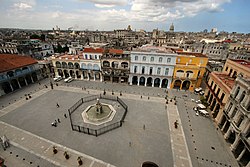
|
|
| Plaza Vieja in Old Havana |
|
| National territory: |
|
| Type: | Culture |
| Criteria : | iv, v |
| Reference No .: | 204 |
| UNESCO region : | Latin America and the Caribbean |
| History of enrollment | |
| Enrollment: | 1982 ( session 6 ) |
The old town of Havana (Spanish: La Habana Vieja ) is particularly worth seeing , it is one of the oldest Spanish colonial settlements and shines on an area of 4.37 km² with its baroque and neoclassical monuments. Due to its eventful history, many other architectural styles of the New World are represented in Havana's old town, including Art Deco . It was already in 1982 under the UNESCO - World Heritage Site made and has since been restored piecemeal. La Habana Vieja is the centerpiece of the city, founded in 1519, which also houses the port from which the Spaniards conducted their trade with America. Here are over 900 buildings of historical relevance, including the four historical squares around which Havana developed: Plaza Vieja , Plaza de la Catedral , Plaza de San Francisco and the Plaza de Armas . The four squares each had different functions: the Plaza Vieja was usually the place for the market, while the Plaza de la Catedral was the religious center of the city. Military parades were mostly held in the Plaza de Armas, while the Plaza de San Francisco was home to the most important Spanish shipyard. The squares are all connected by cobblestones and are used as the venue for various cultural events, with the Plaza de Armas usually having a book market. The places have now been completely restored.
One of the most beautiful buildings in the old town is the 'Palacio de los Capitanes Generales', the former governor's palace. Also worth seeing is the Castillo de la Real Fuerza , the oldest fortress in America built by Europeans. The Parque histórico militar Morro-Cabaña (short: La Cabaña ) is located on the opposite bank of the bay and is the largest Spanish fortification in America. Adjoining it is the Castillo de los Tres Reyes del Morro , the famous fort from the 18th century, on which Havana's striking lighthouse has been located since 1844. The Cathedral of the Archdiocese of Havana , the Catedral de San Cristóbal de la Habana , is also located in the old town. The remains of Christopher Columbus rested in the baroque building from the 18th century until 1898. The Edificio Bacardí , completed in 1929 and the former owner of the rum brand of the same name, is considered a prime example of Art Deco architecture in Havana .
In La Habana Vieja there are numerous important museums of the city, for example the Museo de del ron on the history of Cuban rum production or a museum about Alexander von Humboldt. Particularly outstanding are the Naval Museum Museo de Navegacion and the City Museum Museo de la Ciudad . The car-free street Calle Obispo is the main artery of Havana's old town and is home to numerous art galleries, pubs and tourist attractions.
Centro Habana
The center of Havana (Spanish: Centro Habana ) covers an area of 3.42 km² and extends west of the Prado , along the Malecón to Vedado. With the beginning of colonization from the 16th century, there were already some settlements in the area of today's center, but it did not gain greater importance until the middle of the 18th century with the economic liberalization during the British occupation. At the end of the 19th century, Chinese immigrants settled in the area around Calle Zanja and Calle de los Dragones (Street of the Dragons). They founded various businesses and developed into one of the most important Chinese communities in exile in America. This is where the now well-known Chinatown Havana (Spanish: Barrio Chino ) was built. Although of little tourist importance, Centro Habana is a commercial center of Havana. Along the traditional Neptuno shopping street, smaller private businesses and shops have increasingly emerged in recent years, enhancing the attractiveness of the center.
The most important buildings in the center include the Capitolio , designed according to its model in Washington, DC , as well as the former presidential palace, which today houses the Revolution Museum, and the Gran Teatro de La Habana . The latter is the oldest active theater in Latin America and one of the most magnificent of its kind in this hemisphere. It is the seat of the famous Cuban national ballet. It offers a variety of cultural events such as B. Ballet performances by the national ensemble. Havana's first hotel, the Hotel Inglaterra , which opened in 1856, is also located in the center. It is known for its neoclassical architecture and José Martí gave a speech here in 1879.
The national art museum (Spanish: Museo Nacional de Bellas Artes ) is considered one of the best art museums in the Caribbean and shows international and Cuban art spread over several floors, including Roman mosaics or works by European artists such as Thomas Gainsborough . The most striking street in the center is the Paseo de Martí , also known as the Prado . Construction on this wide boulevard began in the late 18th century and was completed in the mid-1830s. This is also where Cuba's most important ballet academy is located, the Escuela Nacional de Ballet and a large statue of Máximo Gómez .
The structural fabric in the Centro is worse than in the redeveloped old town, however, more and more buildings in the center have recently been redeveloped, the majority of which date from the 19th century.
Vedado
The district of Vedado is the modern center of Havana. Today it is summarized under the administrative unit Plaza de la Revolucion and includes an area of 12.26 km². It is younger than Centro Habana , the first houses were built here from 1860. Vedado's heyday began in the 1920s and lasted into the 1950s. The architectural style is determined more than in other parts of Art Deco elements, some skyscrapers also bear witness to the American influence during the heyday of Vedado. Many casinos and nightclubs from those years that were frequented by actors and wealthy Americans are located in this area.
One of the most important buildings in Vedado is the Hotel Nacional , built in 1930 and built in the neoclassical style. Today it is considered a national monument due to its eventful history, in which it hosted personalities such as Ernest Hemingway . Also famous is the Hotel Habana libre , the city's former Hilton Hotel from which Fidel Castro ruled for the first months after the victory of the revolution. Another attraction is Revolution Square ( Plaza de la Revolución ), which was built under the auspices of Batista. The square is characterized by a 142-meter-high obelisk, which, together with a seated statue, reminds José Martí of the poet and freedom hero . Government buildings, which, like the monument, date from the years before the Cuban revolution, are grouped around the huge square. Including the Ministry of the Interior with a mural of Che Guevara made of steel and the monumental building of the Central Committee of the Communist Party of Cuba (PCC) . In addition, the Havana library is located right on the square. On May 1st, the square fills with millions of people arriving from all over the country to celebrate the holiday.
Not far from Revolution Square is the largest cemetery in Latin America, the Cementerio Cristóbal Colón . The University of Havana is also based in Vedado, it is the oldest university in Cuba and one of the first on the entire continent. The busiest street in Vedado is by far Calle 23 , also known as La Rampa . It is a popular meeting point, where important buildings such as the Yara cinema , various parks and a branch of the Coppelia ice cream chain are located. The United States' interest group in Cuba is also located there, and the anti-imperialist tribune is directly adjacent.
Outskirts of Havana
Overview
Havana's center is surrounded by suburbs to the west, south and east, which have their own historical development and, despite their less tourist attraction, offer many interesting places. In addition to the classic outskirts such as Playa, Mariano and Regla, Havana's “house beaches”, the Playas del Este, are also worth mentioning, which are used by thousands of Cubans every summer for relaxation. The Parque Lenin south of the city has room for parties and events and is mainly used for recreation.
Playa
The Russian embassy and the Museum of the Interior Ministry, which goes into the history of the institution, are located in the Playa district. The national aquarium (Spanish: Acuario Nacional ), the most impressive in all of Cuba, attracts Cubans and tourists with its regular dolphin shows. The Iglesia Jusús de Miramar , Cuba's second largest church, built in 1948 , is also located in Playa.
The Instituto Superior de Arte , founded in 1961, is Cuba's most important art academy, with around 800 students studying here. The Palacio de las Convenciones was built in Playa in 1979 and is Cuba's most important event hall with space for over 2,000 people. Here, among other things, the sessions of parliament and the party congresses of the PCC are held, but the building is also the venue for numerous international conferences every year. The Municipio Miramar is home to the Karl Marx Theater (Spanish: Teatro Carlos Marx ), which has a capacity of 5,500 people and is used for major events such as jazz and film festivals.
economy
Despite the government's efforts to promote industrialization in other parts of Cuba, Havana is still the most important industrial location in Cuba and has a diversified economic structure. Historically, Havana benefited primarily from the sugar industry in the area; today, light industry , metallurgy and manufacturers of chemical products as well as the food industry are mainly present in the city. Many important Cuban companies have their headquarters in Havana, including the largest Cuban company, the trading company CIMEX and the telecommunications provider ETECSA . A total of 714 state-owned companies have their headquarters in Havana, that is 32% of all companies in the country. Numerous pilot projects of the current economic reforms also have their focus in the capital. More than 60 percent of the non-agricultural cooperatives introduced in 2013 are based here.
In addition to tourism , the construction and communication industries are also of great importance . The new technology branches such as biotechnology or information technology as well as pharmaceutical companies are also based on site. Other important industries are shipbuilding, vehicle construction, alcohol production (including rum), textile production and tobacco processing. Cigars that are rolled in Havana are named after the city of Havana . All other cigars are not allowed to use this name.
Havana's port is still of economic importance today, a large part of Cuban imports and exports are handled through it. The port is also the mainstay of the local fishing industry. Since 2014, however, it has gradually been replaced by the port of nearby Mariel , which has meanwhile been expanded to become the largest container port in the Caribbean. The waterfront promenade including the harbor district is to be expanded for tourist use in the coming years. A new train line connects the capital with the port of Mariel .
In addition, many foreign companies are represented in Havana, e.g. For example, the Egyptian bus manufacturer Manufacturing Commercial Vehicles in a joint venture with the Ministry of Transport, which is also the local general importer for the brands of the parent company Daimler . However, models of the in-house brand MCV are also produced.
In a ranking of cities according to their quality of life worldwide, Havana took 192nd place out of 231 cities examined in 2018.
tourism
Due to the dissolution of the Soviet Union and the severe economic crisis that followed, the special period began in Cuba in 1991, which was also characterized by daily power cuts and supply crises in Havana. In order to receive urgently needed foreign currency , Cuba built a tourism industry in the 1990s , the focus of which is in Havana, among other places. Today tourism is Havana's largest industry. In 2010, 1.17 million tourists visited the city, 46% of all visitors to the country. The city offered 12,459 rooms to tourists in 2011. That is 21% of all rooms in the Cuban tourism industry (with a total of 58,188 rooms). Tourism brought Havana US $ 30.3 million that year . In 2016, a cruise ship from the United States reached the city for the first time , but only three years later, US President Donald Trump again prohibited cruise ships from the United States from docking in Cuban ports.
statistics
In 2011, 907,016 people were employed in Havana, 82.6% of them in the public sector. By May 2013, 1,180 small private companies took advantage of the opportunity to lease vacant properties from the state. In 2011, 4,361 new residential buildings were built in the city, two thirds of which were on government initiative.
The city of Havana consumed 2.04 GWh of electrical energy in 2011, 11.5 percent of Cuba's total energy demand. Almost 52 percent of the city's energy needs were consumed in the three most power-hungry districts of Playa, Plaza de la Revolucion and La Habana Vieja. In 2012, US $ 79.6 million was invested in Havana, US $ 2.4 million less than in 2011. In 2011, investments were mainly divided into the following sectors:
- Hotels and restaurants: 22.94 percent (US $ 22.09 million).
- Business Services and Real Estate: 15.91 percent ($ 15.92 million).
- Manufacturing industry (excluding sugar industry): 12.68 percent (US $ 10.39 million).
- Administration and Public Safety: 8.44 percent ($ 6.92 million).
- Transport, logistics and communication: 8.30 percent (US $ 6.80 million).
In terms of geography, investments in 2011 were mainly distributed among the following city districts:
- La Habana Vieja: 35.25 percent (US $ 28.9 million).
- Plaza de la Revolucion: 23.13 percent (US $ 18.97 million).
- Playa: 20.92 percent (US $ 17.15 million).
- Boyeros: 8.6 percent (US $ 7.05 million).
In 2011, the city had total revenues of US $ 136.25 million with expenses of US $ 93.7 million. The city’s largest spending was in the following areas:
- Health: 33.03 percent (US $ 30.9 million).
- Education: 23.38 percent ($ 26.6 million).
- Housing and Community Services: 11.71 percent (US $ 11 million).
Infrastructure
traffic
The city is also the most important traffic center in the country. Havana has an extensive bus system that has been greatly expanded and modernized in recent years. Nevertheless, as everywhere in Cuba, public transport fares are extremely low, but tourists usually pay a higher price in convertible pesos (CUC). On July 1, 2013, the government announced that it wanted to reorganize Havana's transport system and completely overhaul it.
Havana MetroBus
Havana's MetroBus system serves the urban area within a 20 km radius. A total of 1,344 buses are in use in Havana, transporting over 350 million passengers annually (2011). The central bus station is the Terminal de Ómnibus in Vedado. The buses run in 17 lines through the entire city area. The stops are located at an average distance of 800 to 1000 meters, and during rush hour many lines run every 10 minutes. Vehicles of the brands Yutong , Busscar and MAZ are mostly used today . Each line designation begins with the number "P":
- P-1 : La Rosita - Playa
- P-2 : Alberro - Vedado
- P-3 : Alamar - Túnel de Línea
- P-4 : San Agustín - Playa - Terminal de Trenes
- P-5 : San Agustín - Centro Habana - Terminal de Trenes
- P-6 : Reparto Eléctrico - Vedado
- P-7 : Alberro - Parque de la Fraternidad
- P-8 : Reparto Eléctrico - Villa Panamericana
- P-9 : La Palma - CUJAE
- P-10 : Víbora - Playa
- P-11 : Alamar - El Capitolio - Vedado
- P-12 : Santiago de Las Vegas - Aeropuerto - Parque de la Fraternidad
- P-13 : Santiago de Las Vegas - La Palma - Parque de la Fraternidad
- P-14 : San Agustín - Parque de la Fraternidad
- P-15 : Alamar - Guanabacoa - Vedado
- P-16 : Santiago de Las Vegas - Vedado - Ameijeiras Hospital
- PC : Hospital Naval - Playa
Omnibus Metropolitanos
The buses of the Omnibus Metropolitanos (OM) connect the city center of Havana with its suburban suburbs within a radius of 40 km. It is the most frequented and largest fleet of urban buses in the country; most of the vehicles are modern Chinese Yutong buses, which have been purchased in large numbers since 2008.
Astro and Víazul
The bus company Astro offers overland trips for Cubans, but tickets have not been sold to tourists since 2010.
However, throughout Cuba there is a special bus network for tourists called Víazul . The fleet consists of modern Chinese buses and connects all major cities on the island. From Havana there are connections to all provincial capitals, the fares are between 10 (Varadero) and 44 CUC (Bayamo) depending on the distance.
Air traffic
The air traffic in the city of Havana and its surrounding area is served by Havana's "José Martí" airport (Spanish: Aeropuerto Internacional José Martí ). It is located about 11 km south of the city center, in the Municipio Boyeros and is the main port of the Cuban airline Cubana . The airport is one of the most important in the country, both for domestic and international flights. It was built in 1930 and has been expanded several times since then. Today it has three terminals and a 4000-meter-long runway. The airlines on offer connect Havana with the Caribbean, South America, North America, Europe and Africa.
There is also a smaller airport called Playa Baracoa west of Havana, which is mostly used for domestic flights.
Rail transport
Havana is connected to the Cuban network of regional, interregional and long-distance trains, which connects the city with all other Cuban provinces. The main train station is the Estación Central de Ferrocarriles in La Habana Vieja. Between eight and nine million passengers are carried annually from Havana's train stations.
Every three days there is a night train to Santiago de Cuba and Guantánamo, with stops in Santa Clara and Camagüey. A ticket for the entire route costs 50 CUC.
In addition to the main train station in Havana, there is a small train station in the Casablanca municipality, from which the famous Hershey Railway goes to Matanzas. This is also the only electrified railway line in the Caribbean. A ticket costs around 1.50 CUC.
shipping
Havana Bay is one of the safest ports in the world. Access to the open sea is limited by the nature of the coastline to a very narrow entrance, which was also the decisive reason for the city's foundation at this point. Today the port is used for both goods and passenger traffic. However, most of the container traffic has recently been moved to the new deep-sea port of Mariel 45 kilometers west of Havana. A ferry connects the old town of Havana with the districts of Regla and Casablanca, which leaves from Muelle Luz about every 10-15 minutes . The trip costs around 1 CUC for tourists.
Furthermore, a hydrofoil goes to Isla de la Juventud every day . Shuttles to the boat leave every morning at 9 a.m. from the central bus station.
Road network
Havana's road network has been laid out generously, but is partly in poor condition due to a lack of maintenance. The main road connections are:
- A1 - Autopista Nacional, from Havana to Santa Clara and Sancti Spíritus , with an additional route to Santiago and Guantánamo
- A4 - Autopista Este-Oeste, from Havana to Pinar del Río
- Via Blanca , to Matanzas and Varadero
- Havana's city ring that starts at the Havana tunnel under the entrance to the port.
- Autopista del Mediodia , from Havana to San Antonio de los Baños
- a highway from Havana to Melena del Sur
- a highway from Havana to Mariel
There are numerous taxis in Havana, including state-owned Cubataxi , Panataxi and Taxi OK taxis that can only be used to pay with CUC. There are also a large number of private and cooperative taxis, from vintage cars to modern small cars, all vehicles are used. A specialty are the collective taxis (Spanish: Colectivos ) which usually go to longer distant destinations with several passengers. A cheap alternative for short journeys are the bicycle taxis called Bicitaxis , which run all over the city.
Havana is also famous for its old cars. In addition to American classic cars , mostly from the 1950s, vehicles from the Russian automobile manufacturers Lada , GAZ and UAZ characterize the cityscape.
education
Havana has a broad educational landscape. There are 416 crèches with 51,543 places available, of which just under 70 percent are used. Furthermore, there are 518 primary schools, 182 secondary schools and 32 pre -university schools in Havana for obtaining university entrance qualifications. 51 schools are available for technical training and there are also 65 special educational institutions, e.g. B. for autistic people. The graduation rate in primary school is 100 percent in Havana, and 97.5 percent in secondary schools.
The University of Havana is located in the Vedado district and was founded in 1728. It is one of the oldest on the continent and was one of the leading educational institutions in America during the 18th century. Today around 60,000 Cubans study here.
Other important educational institutions in Havana are:
- Instituto Superior de Arte
- Instituto Superior Politécnico , better known as CUJAE
- Escuela Nacional Cubana de Ballet
- Escuela Latinoamericana de Medicina , (1999)
There are 647 facilities available for sport in Havana, including 352 sports fields, 286 sports halls and 9 swimming pools.
health
All Cubans have access to the nationwide free health system, which in Havana also has numerous local family doctors in the individual municipalities as well as central hospitals, polyclinics and special facilities. In 2011 there were 2,775 medical facilities in Havana, including 40 hospitals with over 16,000 beds. A total of 16,224 nurses and 2,355 family doctors worked in the city this year. The maternal mortality rate in 2011 was 59.2 out of 100,000, which is above the Cuban average (40.6). In terms of child mortality, Havana is 4.3 per 1000, below the national average (4.9).
Personalities
Havana is the birthplace of numerous famous personalities including:
literature
- Sven Creutzmann (photos) / Bert Hoffmann (text): Havana. In the heart of Cuba . Verlag Frederking and Thaler, Munich 2019, 320 pp. ISBN 9783954162864
- Gerhard Drekonja-Kornat (ed.): Havanna. Past, present, future . LIT Verlag, Münster-Vienna 2007. ISBN 978-3-7000-0648-0 .
- Barbara Dröscher: Havana lessons. Cuba between everyday life, culture and politics . ed. tranvía, Berlin 2011, ISBN 978-3-938944-51-6 .
- Michael Eastman: Havana . Prestel Verlag, Munich 2011, ISBN 978-3-7913-4623-6 .
- Reinhard Kleist: Havana. A Cuban trip . Carlsen, 1st edition 2008, ISBN 978-3-551-73434-1 .
- Eduardo Luis Rodriguez: The Havana Guide - Modern Architecture 1925–1965 . Princeton Architectural Press, ISBN 1-56898-210-0 .
- Jens Sobisch: City Guide Havana and the surrounding area . Reise Know-How Verlag Rump, 335 pages, 2nd edition, Bielefeld 2008, ISBN 3-8317-1394-4 .
Cinematic reception
- Suite Havanna / Suite Habana , director: Fernando Pérez , Kuba, 2003, 80 min
- Our man in Havana , based on the novel of the same name by Graham Greene , director: Carol Reed , GB, 1959, 111 min
- Strawberry and Chocolate / Fresa y Chocolate , directed by Tomás Gutiérrez Alea , Juan Carlos Tabío , Cuba, 1994, 106 min
- Dirty Dancing 2: Havana Nights , 2004
- Habana Blues , 2005
- Havanna , director: Sydney Pollack , USA, 1990, 140 min
- Buena Vista Social Club , director: Wim Wenders, USA / France, 1999, 105 min
- Havana - The new art of building ruins , Germany, 2006
- Rincón , Germany / Cuba, 2005
Web links
Individual evidence
- ↑ Archive link ( Memento of the original dated February 5, 2010 in the Internet Archive ) Info: The archive link was inserted automatically and has not yet been checked. Please check the original and archive link according to the instructions and then remove this notice.
- ↑ a b http://www.one.cu/publicaciones/cepde/cpv2012/20131107resumenadelantado/Tablas/1.pdf ONE, Census 2012
- ↑ Capital city - capital of Spanish Cuba in 1552
- ↑ 15.7 - Visitantes por mes ( Memento of the original from April 1, 2013 in the Internet Archive ) Info: The archive link was inserted automatically and has not yet been checked. Please check the original and archive link according to the instructions and then remove this notice. ( MS Excel ; 63 kB)
- ↑ 2.3 - Temperatures máximas y mínimas absolutas registradas, ONE ( Memento of the original from January 9, 2014 in the Internet Archive ) Info: The archive link was inserted automatically and has not yet been checked. Please check the original and archive link according to the instructions and then remove this notice. ( MS Excel ; 63 kB)
- ↑ Cuba compact , March 2005 edition, p. 2 (PDF; 72 kB), accessed on March 3, 2010
- ^ Crumbling Romanticism (title of the print edition) , NZZ, July 15, 2016
- ↑ ASAMBLEAS PROVINCIALES DEL PODER POPULAR
- ↑ Asociation de Agencias de Turismo del Cusco: Ciudades hermanas
- ↑ a b Gran Teatro de La Habana. ( Memento of the original from August 23, 2014 in the Internet Archive ) Info: The archive link was automatically inserted and not yet checked. Please check the original and archive link according to the instructions and then remove this notice. In: Ballet Nacional de Cuba (Spanish).
- ↑ Organización institucional, principales entidades , ONE 2014
- ↑ Ciudad y puerto, el futuro de La Habana ( Memento of the original from February 8, 2015 in the Internet Archive ) Info: The archive link has been inserted automatically and has not yet been checked. Please check the original and archive link according to the instructions and then remove this notice. , Cuba contemporánea of February 3, 2015
- ↑ Mercer's 2018 Quality of Living Rankings. Retrieved July 30, 2018 .
- ↑ 15.8 - Capacidades de alojamiento del polo turístico, ONE ( Memento of the original from April 1, 2013 in the Internet Archive ) Info: The archive link was inserted automatically and has not yet been checked. Please check the original and archive link according to the instructions and then remove this notice. ( MS Excel ; 62 kB)
- ↑ 15.1 - Ingresos y otros indicadores asociados al turismo, ONE ( Memento of the original from April 1, 2013 in the Internet Archive ) Info: The archive link was inserted automatically and has not yet been checked. Please check the original and archive link according to the instructions and then remove this notice. ( MS Excel ; 71 kB)
- ↑ 5.3 - Principales indicadores económicos globales del sector estatal, ONE ( page no longer available , search in web archives ) Info: The link was automatically marked as defective. Please check the link according to the instructions and then remove this notice. ( MS Excel ; 65 kB)
- ^ Self-employed in Havana Choose Rental of State Facilities for their Businesses, ACN, May 3, 2013
- ↑ 11.2 - Viviendas terminadas, ONE ( page no longer available , search in web archives ) Info: The link was automatically marked as defective. Please check the link according to the instructions and then remove this notice. ( MS Excel ; 61 kB)
- ↑ 9.2 - Consumo de energía eléctrica por organismos seleccionados ONE ( Page no longer available , search in web archives ) Info: The link was automatically marked as defective. Please check the link according to the instructions and then remove this notice. ( MS Excel ; 62 kB)
- ↑ 9.12 - Consumo de energía eléctrica por municipio, ONE ( page no longer available , search in web archives ) Info: The link was automatically marked as defective. Please check the link according to the instructions and then remove this notice. ( MS Excel ; 67 kB)
- ↑ 11.9 - Volume de inversiones por clase de la actividad económica ( page no longer available , search in web archives ) Info: The link was automatically marked as defective. Please check the link according to the instructions and then remove this notice. ( MS Excel ; 63 kB)
- ↑ Raul: Continuamos Avanzando y se notan los resultados. Granma, July 1, 2013.
- ↑ 12.7 - Pasajeros transportados, ONE ( page no longer available , search in web archives ) Info: The link was automatically marked as defective. Please check the link according to the instructions and then remove this notice. ( MS Excel ; 62 kB)
- ↑ 16.4 - Total de centros funcionando por tipo de educación del Ministerio de Educación, ONE 2011 ( page no longer available , search in web archives ) Info: The link was automatically marked as defective. Please check the link according to the instructions and then remove this notice. ( MS Excel ; 68 kB)
- ↑ 16.1 - Indicadores generales de círculos infantiles (Cierre 31 de Diciembre del 2011), ONE 2011 ( page no longer available , search in web archives ) Info: The link was automatically marked as defective. Please check the link according to the instructions and then remove this notice. ( MS Excel ; 63 kB)
- ↑ z. E.g .: Velódromo Nacional Reinaldo Paseiro
- ↑ 19.2 - Instalaciones deportivas del INDER, ONE 2011 ( page no longer available , search in web archives ) Info: The link was automatically marked as defective. Please check the link according to the instructions and then remove this notice. ( MS Excel ; 62 kB)
- ↑ 19. Salud Publica y Asistencia Social, ONE 2011 (PDF; 435 kB)






